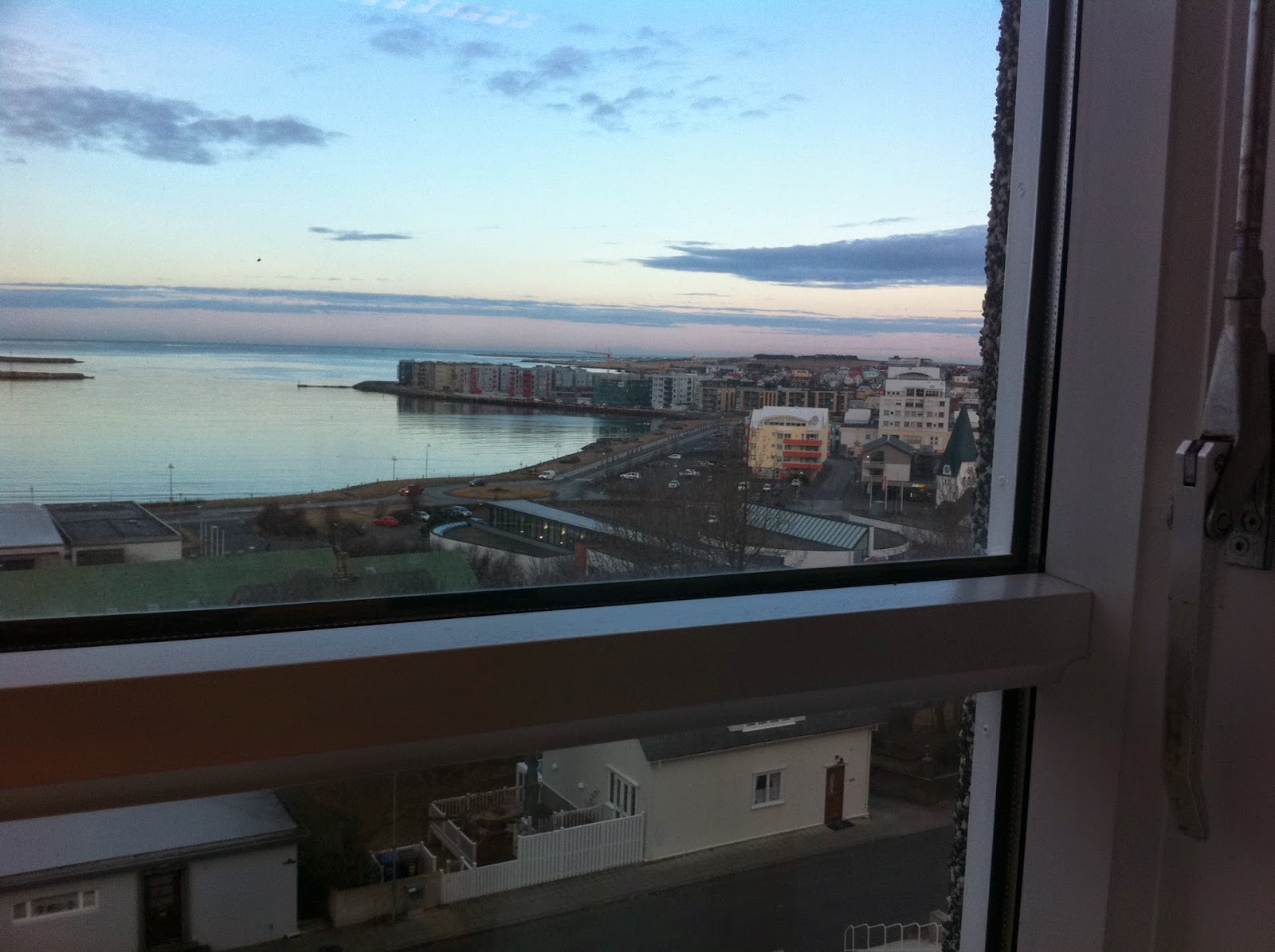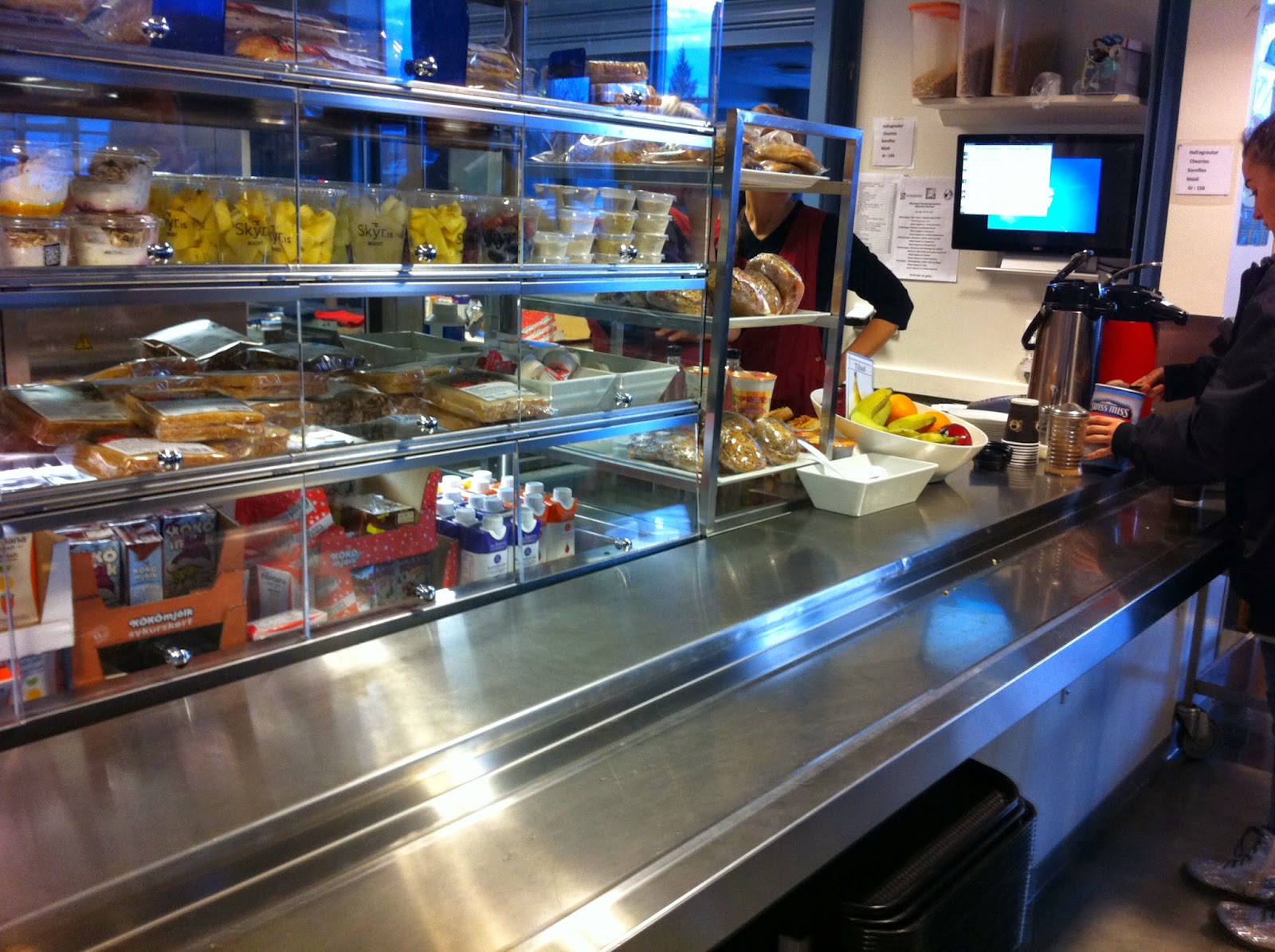Focusing on health
This year Iceland has the chairmanship in the Nordic Council of Ministers and its program New Nordic Food (II), the project Food, Children and Health together with our co-partner the network “BoMIN” (Sweden) had the opportunity to make a visit to Iceland. The aim was to share and exchange experiences in the field.
Beautiful view from a school window in Reykjavik.
You learn a
lot when meeting and interacting with each other. I was informed that the
Iceland introduced public food, with warm school lunch in the year 2000. It is a remarkable long time for public meals in Finland, that introduced warm school
lunches in public school in the year of 1948. On Iceland it is mainly financed
from municipalities and families pay some of the costs. In the end of the
90-ties they start a health promoting work in the country.
Iceland, Sweden and Åland/Finland meeting up:
Bryndís Jóna Jónsdóttir, Fredrik Ljung, Ellinor Christensson, Harriet Strandvik,
Inga Birna Albertsdóttir, Sigrún Daníelsdóttir
It has been
many years of strategically work for promoting a healthier society included the
schools. The changing process goes thru numbers of health promotion project
schools. We had the honour to visit two of them. One was a pre-school, under the
name “Skolar”. The other was a secondary school, “Flengsborgarskolar”.
Pre-school, at "Skolar". The smal kids eat their meals together with an adult in the middel of an almost round table. The school was very popular with its strategic work for health.
In the
afternoon after the school lunch we visit the Directorate of Health, where they
told us about the background for health promoting activities on Iceland. The
next focus is now strategic work with health promoting communities. But good
changings starts with the kids. It was nice to see that many schools had been
working actively for a long time focusing on health including work with
nutrition.
Fish-soup of the day. My reflection on the lunch was: How can they increase the numbers of guests in the cantina? Surprisingly few were eating the lunch.
Proudly presenting certifications of health promoting work thru the years.
The cantina was integrating into the school system. The were active of offering good chooses of snacks and drinks. No sodas and not candies.
Good ideals
The small
group from the Nordic network also had the opportunity to talk about what is
going on, on Nordic level. There has been a lot of different project that
easily can be transformed into other countries. During the day I was focusing
on the method SAPERE and found out that it was not used in the schools. A
interesting connection with senses and teaching about consciousness food
consumption is the link to mindfulness.
Harriet teaching SAPERE at a school in Finland
The
Flengsborgar school was in the beginning of working with mindfulness as a
important part of young people today. They had got inspired from Scotland about
the good effect of integrate it into schools. At the Flengsborgar school they
had plans for introduce it also in the meals. We can al image how good it would
be offering a calm and peaceful environment around (public) meals. I am sure it
give good effect on the meal-situation and how the body assimilate nutrients.
We also
picked up a good ideal of integrate students into the work of develop healthy
chooses and activities. At Flengsborgar school they have had a competition of
making new smoothie recipe’s. They let the student test out a recipe and make it
in front of a audience, like a show for good food!
What is SAPERE?
The
teaching method SAPERE was something new and it rise the question what it is? The
word is Latin, and was taken from (homo) sapiens, it stands for tasting, smelling, but also clearness and wisdom. Jacque Puisais developed the method in France around the
80-ties. There were some remarkable good effects on pupils learning-skill in al
subject when he introduced training in senses. It was then developed into topics like
a sequences for teaching.
In the
90-ties it started to developing in Sweden, it came to Grythyttan, in Örebro. It was
translated into Swedish and in cooperation with staff both from kitchen and
pedagogues it was learned out as a good learning tool in different communities
in Sweden. After a while it also was spread to Finland. The method in Sweden is
divided in 10 different lessons that can be integrated in normal curriculum
during one semester. For the moment it is going to be republished and up-dated
and it will be found free to use at the webpage of the Swedish Food Department,
“Livsmedelsverket”.
In Finland
there has been a large work of using the method in kindergarten. We are now
talking about “Ruokakasvatus” in Finland. (Finish word for Food Education. It
is called “Måltidspedagogik” in Sweden). I think that the method SAPERE is a
very good function to build bridges between classroom and public meal.
What do the students learn from SAPERE?
•
Will
learn about senses and individual taste
•
Will
learn the ability to express themselves
•
Will
develop consciousness consumer behaviour
•
Will
raise curiosity about new product and courses
•
Will
increase the variation in food consumption.
"Smörgåsbord" of ideals from Nordic countries
I will now collected and share some good projects and ideas of what is going on in Nordic countries and you can of cause steal ideas and get inspired of them!Sweden
- "FriskaBarn" A evidence based method of how to increase good habits of food and physical activities. It is a self developed method focusing on the pedagogues (al staff) as a roll model:
- A tool, "Skolmat Sverige" for evaluating school-meals in Sweden, focusing on nutritions:
- Here you can find the guidance in swedish: "Handboken: Mat för alla sinnen" . More information about the method is at the webpage, "Livsmedelsverket"
Norway
- Fiskesprell: Tools for teachers in home economics and health subject of using fish and teaching about the benefit of fish-consumption. New material and guidelines are recently published.
Finland
- A new research in Finland about the effect of having SAPERE / Food Education in the curriculum. The research is only in finnish.
- Here is useful guidance from Finland, about SAPERE to be use for example in youth clubs: "Sinnrikt i matvärlden". (In swedish)
- Finland svenska Marthaförbund - an organization spreading the method among kids, in private kindergarden. They have a nice website: "Tack för maten"
Denmark
- Her you can find useful tools on the web in SAPERE in al nordic languages! "Säg MUMS till Norden!"
-









Inga kommentarer:
Skicka en kommentar